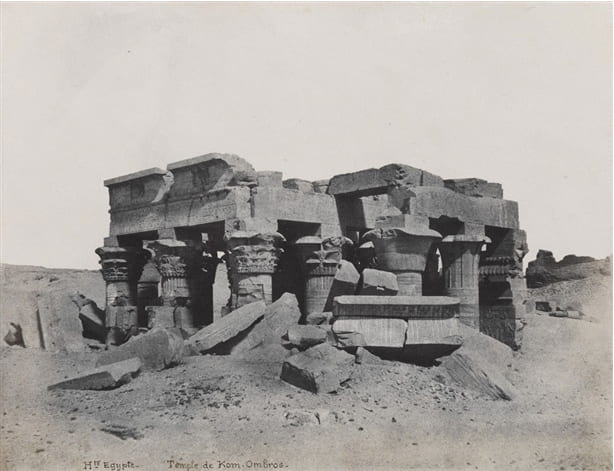The Paris-born American photographer John Beasley Greene (1832–1856) traveled to Egypt and northern Nubia in 1853–54, recording more than two hundred images of the region’s landscape and monuments. As an avid archaeologist, Greene also performed excavations around Thebes, mainly at Medinet Habu. He was one of the first photographers to use the camera in the service of archaeology. His photographs of ruins employ a spare, almost abstract aesthetic to record a maximum of archaeological information and suit the scientific aspect of his mission. In Temple of Kom-Ombos, Upper Egypt, Greene took a closely cropped view of the structure, eliminating the visual noise of its environment. He framed its entablature against a bleached white sky, like a scientific specimen isolated on a blank page. He further utilized stark contrasts of light and dark to enhance the temple’s volumes and decorations. The interior of the temple, which is plunged into darkness, points up the elaborate floral carvings on the capitals of the central columns. The absence of human figures does not distract from the picture’s aim to document the architectural monument.
Yet Greene’s image exceeds its documentary ends to poetically meditate on temporal loss. A chaotic mass of debris in the center foreground obstructs the viewer’s access into the temple and may symbolize the frustrating inaccessibility of the past. Deep shadows conceal large parts of the temple and thus dramatize the fragmentary nature of its ruins.[62] Greene centers the photograph around a void—the cavity smashed through the cornice—as if to concentrate on the ravages of time rather than the architectural remnants. The picture projects a haunting sense of waste and a philosophical awareness of the ephemerality of man, both themes in Romantic art and literature of the period. The photograph’s feeling for existential tragedy foreshadowed Greene’s death in Cairo just two years later, at the untimely age of twenty-four.
Image credit:
John Beasley Greene (American, 1832–1856), Temple of Kom-Ombos, Upper Egypt, 1854. Salted paper print mounted on engraved paper, 9 3/16 x 12 in. Mildred Lane Kemper Art Museum, Washington University in St. Louis. Gift of Laurie Wilson, Robert Frerck, and family, 2015.
